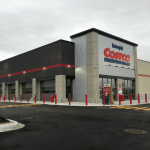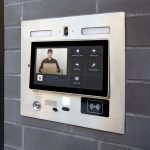This article reports on research completed as part of a contract from the U.S. Architectural and Transportation Barriers Compliance Board. The goals of the project were to complete a state of the art review on the subject of automated doors and develop recommendations for revising the ADA Accessibility Guidelines(ADAAG) in light of the findings. These recommendations address both scoping criteria when and if automated doors should be required, and technical criteria for how they should be designed if they are used in buildings. The article summarizes the findings of the research and the recommendations.
From the “Flash Gordon” serials in the ’50’s to Star Trek, the Next Generation, the automated door is a ubiquitous element in science fiction. Yet, after 40 years of imagery, life still has not imitated art. The automated door has yet to become universal.
Automation is generally reserved for two purposes, accommodating high flows of pedestrian traffic and providing accessibility for people with disabilities. The main source of technical design criteria for accessibility is ANSI A117.1 (1986) Standard, Making Buildings and Facilities Accessible to and Usable by People with Disabilities. This voluntary standard is currently referenced directly or indirectly by many state accessibility codes. The standard includes maximum values for the opening resistance force for manual doors. A door that has greater opening resistance must be automated. Existing human factors research indicates that many people with disabilities cannot open doors with resistive forces as low as those specified in ANSI A117.1(1986). Yet, these requirements have been a source of concern for closer manufacturers, architects and code officials for many years who believe that the criteria are too stringent and lead to situations where doors will not close properly. In fact, the Uniform Federal Accessibility Standard (UFAS), the regulations for the Americans with Disabilities Act(ADA) and ANSI A117.1 all omitted requirements for maximum opening force at exterior doors.
The ADA greatly expanded the legal mandate for improved building access. As regulations for the Act were being developed, people with disabilities identified the need for improved accessibility to doors as a major problem. Allowing higher resistance forces for manual doors while, at the same time, requiring automated doors, could overcome industry objections to low opening resistance and address the accessibility concerns as well. In fact, several states have already adopted provisions that mandate automated doors in certain situations. Yet others have increased the maximum limit for opening resistance without requiring automated doors.
There is another important argument for giving more attention to automated doors. The concept of “universal design” has become the focus of accessibility in the ’90’s. Universal design means design that accommodates all people, not only people with disabilities. It includes design that will assist the elderly, children, pregnant women, people carrying packages, etc. Automated doors are a perfect example of universal design. Everyone, even the crew of the Starship Enterprise, benefits from the added convenience they provide. With the advent of the ADA, we can expect that the use of automated door products will increase, even if the federal regulations do not currently mandate their use. The time has come to give this product more attention in design practice.
Door use can be described as a process which includes seven subtasks:
The abilities of the person, the ambient environment and the social context play a major role in successful completion of the task. These factors can affect the perception and understanding of door use as well as the level of stress involved in the task. Stress may be related to limitations in ability, difficult environmental conditions such as low levels of illumination or social pressures such as a crowd of hurrying people. Automating doors is a means to reduce the stress of door use. Automated doors are specifically designed to reduce congestion and increase access, but they also can be helpful to control access and improve security. Although automated doors can reduce accidents, their mechanical operation, which is outside the control of the individual user, also can create potential safety problems. Door use is a critical aspect of safe egress from buildings in emergency situations. Building safety codes and standards reflect this fact through many detailed design criteria. However, during power failures the automatic features may be disabled. Thus, automated doors must be designed to address these emergency concerns if they are part of designated exits.
For people with disabilities, difficulties with door use are more pronounced and often a stressful aspect of everyday experience. Automated doors can make the door use easier. But, as the analysis and model above make clear, many human factors issues that should be addressed in the design of automated door systems. Although much research has been completed about door use, little research has been completed specifically on automated doors. The model of door use can be useful to summarize what we do know and identify the research gaps.
From existing research, we know that understanding the operation of automated doors can be a problem for people with disabilities and the elderly. We do not know how widespread the problem is since the existing research has observations from only a few subjects. New and innovative products, like automated revolving doors, seem to create the most serious difficulties. Although existing safety standards require signage on automated doors, we do not know if those provisions are adequate. Furthermore, no research has been done on how information about door operation should be conveyed to visually impaired individuals. Since people who cannot see use their hands and canes to learn about the operation of doors and devices they encounter, attention should also be given to safety for tactile exploration.
Although considerable research has investigated the need for maneuvering clearances in front of doors, no attention has been given to maneuvering clearance necessary at power assisted doors.
There has been considerable research on the use of handles, switches and locks by people with disabilities. This research includes specific studies on card slots, push buttons, keys and other devices that are used with locks. Often doors equipped with power operators have high-tech security devices like card readers. There is information on how to make such systems accessible.
From the perspective of accessibility, the specification of automated doors is tied to the force required to open doors. If a door handle, lock or door presents too great a resistive force for people with disabilities to overcome, then an automated system can be specified to substitute. Much research has been completed on the subject of opening doors against the resistive forces of mechanical closers and air pressure differentials. Although some of the findings are divergent, they can be explained by differences in research methods and sample selection. Given the purpose and intent of an application, it is possible to use the existing data base to make appropriate recommendations for maximum resistance forces (minimum opening forces) at manual doors.
Research indicates that the abilities of the more severely disabled population to resist the forces of door closers are very limited. Closers are not currently designed with a level of efficiency that would allow all doors to close properly if the opening force were set at the limit that this group of people could manage on an everyday basis. Furthermore, many people with severe disabilities have limited use of their hands and arms.
Only one study has been completed on emergency use of doors. When compared to other studies, the findings indicate that, under emergency conditions, people with disabilities can exert relatively high forces to overcome the resistance of door closers. Larger opening forces may therefore be possible for doors used only for emergency use or emergency modes of automated doors.
Research has demonstrated that passing through doors against the resistance of a closer is quite difficult for many people who use wheelchairs, particularly children. The main problem seems to be that do or users have to exert force to keep the door from closing while they are moving through the opening. Safety issues for people who walk or wheel slowly while using automated revolving doors are a special case of this problem. These doors do not really “close”. Thus, the user can be bumped by the leaf behind them. Manufacturers have developed several different approaches to this problem but none has been evaluated in depth.
The samples used in research on automated doors are not fully representative of the disabled community. In particular, very few people with visual impairments have been included. No research has been completed with people who have developmental disabilities or hearing impairments. Field studies have not been conducted with children. In the reports of field research, differences between the people who used the door were not examined in detail. Thus, we have limited information about the variation in abilities among people with different types of disabilities.
The research that has been completed addresses many different types of doors and related devices. However, there are some issues that have only been studied with very small samples of individuals. In particular, systematic variation of different door features on the same type of door is lacking. The ambient environment has received practically no attention. No research has been completed on the impact of differences in illumination, particularly as it relates to signage. The impact of wind and temperature has not been examined. The impact of crowding is another neglected issue. Finally, little research has been completed on the unique concerns of different building types.
Our product search identified 86 manufacturers of door-related products not all of which necessarily make automated products. Letters of inquiry were sent to all of the manufacturers with a request for information on their automated door products, if they produced them. Of the 86 manufacturers, all but 14 responded. Among these respondents, 18 identified themselves as manufacturers of automated door products and sent catalogs on a total of 121 different product lines including 42 activating devices, 40 operating devices and 39 door systems.
Interviews with six manufacturers suggest that most product development is focused on design improvements such as making the devices smaller and less obtrusive, safer and more secure. In the accessibility area, more attention is now being given to wireless remote activation devices. Most companies that produce a large range of different products have specialized devices for accessibility. Other companies specialize in accessibility products only. Some products are specifically designed to assist in converting existing manual doors to automated operation.
According to the manufacturers of manual door closers, identified a key design problem is meeting the requirements of accessibility codes that have limitations on the opening force of exterior doors. The physics behind mechanical door closer design requires the opening force to exceed the closing force. As individuals open the door, they transfer energy to the door closer. The closer stores the energy (in a spring or other device) until the door begins to close. The energy stored is then applied to the door through a lever arm. The efficiency of this operation is only about 60 percent. Thus, an 8.5 lbf. (37.8 N.) opening force(required by some codes for exterior doors) translates into a 5 lbf. (22.2N.) closing force. Manufacturers maintain that such a force is not sufficient to overcome the resistance of door weight, HVAC pressures, wind, gasketing, stiffness of latching mechanisms, installation tolerances, hinge friction, etc. Another problem is that these requirements are difficult to enforce. No one knows what the actual site conditions will be. Installation, maintenance and wind behavior, among other considerations, play major roles in determining the actual forces necessary to close the door as well as the force of opening. Such factors cannot be predicted accurately during the design and specification of products so a factor of safety is needed to ensure proper performance.
The manufacturers also reported that designers (and possibly code officials) have interpreted the existing codes to mean that low energy and power assisted doors must comply with the manual door opening force requirements so that they can be operated manually when power fails. This results in the development of a product that seems redundant. If a door meets opening force requirements, why would a building owner want to pay extra to automate it? Only facilities that seek ultimate convenience would install such systems.
The market for automated doors is becoming more defined. The type of product most appropriate for a particular application is determined by frequency of operation, speed of operation required, new versus existing construction, traffic flow and cost. Products are available to address the full range of applications based on these factors.
Automated door systems include four sets of components: door and frame, opening and closing hardware, operating controls and information display.
The door and frame used determine the clear width of the door and the method of opening. Products are available to automate swinging, sliding, folding and revolving doors. Both opening and closing functions can be automated. Some automation products do both. Others only open the door, relying on standard mechanical closers for the closing function.
Operating controls include switches that require deliberate actions to engage the automated opening/closing device, floor mats that activate a door when someone walks over them during their approach to the door, and sensing systems that activate the door automatically when a person comes within range (Fig. 1). Switches come in many different forms including push buttons or plates, keyed locks, keypad locks and card readers. Many products have remote control options that operate like garage door openers or television remote controls. Additional operating controls regulate the function of the door, depending on actions of the user. The most common devices of this type are safety mats or sensors that prevent the door from hitting a person as it opens. Security functions can be automated as well through the use of an electric latch. The latch may be controlled by the same switch as opening and closing functions, or it may have separate controls.
Information displays are an important part of automated door systems. If an automated door does not have any readily identifying characteristics (e.g. floor mat) labeling should identify it. Without this labeling, the user may be startled by the door when it opens or may not know how to activate the automated features. When automated door systems require specific actions to engage certain features, directions must be communicated to the user. Safety warnings are also required to avoid accidents. For example, one way doors should be labeled to avoid pedestrian collisions in high traffic areas and ensure smooth traffic flow. The most sophisticated doors have audible communication systems to convey operating and safety information.
The availability of options in each component generates a high degree of variability for door systems as a whole. Classification is useful to help in selecting the best options for each application. The most useful classification is based on the force produced by the door as it opens. The industry has developed two voluntary standards that distinguish “full powered” from “low energy” and “power assist” doors. Full powered doors produce more kinetic energy because they open faster. These doors should comply with ANSI/BHMA A156.10. Low energy and power assist doors should comply with ANSI/BHMA A156.19. Full powered doors have more stringent safety requirements. Low energy doors cannot open faster than 3-5 seconds, depending on size and weight. Full powered doors are designed for much more frequent use than low energy doors. They are the type that is typically used at the entries of supermarkets or transportation terminals. These doors always have automated controls such as floor mats or sensing systems. Their primary purpose is to allow a rapid flow of pedestrians. Low energy and power assist doors, on the other hand, are designed for a lower level of use. Their primary purpose is to provide accessibility for people with disabilities and the elderly. They are usually activated by push button or pad.
Full powered doors can only be used in automatic mode except during emergency use. Some low energy doors, however, are de signed to be used both in manual and in automated mode, at the convenience of the user. These doors generally open slowly to preserve kinetic energy. Users who do not want to wait for the door to open can open the door manually and pass through at a higher rate of speed.
Power assist doors provide assistance to augment the user’s application of force. One type reduces the resistance of a manual closer so that the door can be opened more easily. It complements the force of manual operation and is activated automatically as a door begins the opening cycle. This type of operator is used where doors would be difficult for everyone to open and the power assist feature is needed all the time. Power assist doors are often used in health care or industrial facilities where people are carrying heavy loads through doorways. A second type of power assist door is sometimes called “reduced effort.” doors. This type requires the deliberate activation of a switch to engage the operator. The switch reduces the resistance the closer exerts against opening. The switch is needed because such doors are designed for only intermittent power assist use for those people who cannot manage the door without it. The full force of the closer is automatically re-engaged once someone has passed through the door. One product does this by supplying compressed air to the closer. A compressed air system can provide power assist to many doors from one compressor(Fig. 2).
The frequency of traffic at an entrance is not always the major factor in determining the door type and level of automation. Some automated door products are installed solely for convenience. For example, automated folding doors may be used to temporarily partition a space (Fig. 3). As an other example, low energy door systems are often used at entrances that receive a high volume of use. Such entrances would have many doors, one of which is a low energy door that provides accessibility for people with disabilities (Fig. 4). This could be a very appropriate solution where high traffic levels are intermittent, for example, a performing arts facility.
Energy conservation is a major goal in the design of full powered automated door systems. Heavily traffic entrances can be a source of significant energy loss. Revolving doors are used to reduce energy expenditure. Automated revolving doors are one of the newest automated door products. Revolving doors are available in many sizes and configurations (Fig. 5) They can be much larger than manual revolving doors, large enough to be accessible for people who have disabilities. These systems are perhaps the most sophisticated of any automated door product. They can have multiple speeds for different operating modes(standard use, slow use and idle). Some have variable speed features that are automatically adjusted. Sensing systems track the users and adjust the speed of the door accordingly (Fig. 6).
Security is an important concern in the design and specification of automated door systems. Full powered systems are simply turned off when access is restricted. Manual keyed locks are then used to ensure that they will not be pried open. Low powered doors can be locked manually or have electric locking devices. Some automated doors are installed in high security locations. Card readers and combination locks are used to restrict access. In addition, automated revolving doors can be used to trap people who try to enter a high security area and are not authorized to do so. These doors only open enough to let a person pass into a compartment of the door but not onto the other side. They rotate in two steps. If an access code or card is not valid, the door will not complete the cycle and trap the individual within the enclosure. Such doors are usually not large enough to be accessible for people who use wheelchairs.
In contrast, manual emergency access is required at doorways that are part oaf required means of egress. To ensure that automated doors will be operable when the power is off, emergency use modes are designed into the doors. Full powered doors have “break-out” features that allow swinging doors to be pushed open in the direction of travel free of control from the mechanical operator. Sliding automated doors also have such features. The door panels pivot in their tracks upon the application of force. Revolving doors are designed with wings that fold back when enough pressure is applied so that users can walk freely on both sides of the central hub. Low energy doors can usually be operated manually even when the power is off. For locked doors, strikes can be operated either electronically or by a manual exit device.
Accessibility regulations that limit the amount of force allowed to open a door have generated a market for low energy operators. Many of these products are sold as complete systems including door, frame and operator. Other products are sometimes called “retrofit” or “after market” operators. The operator is sold separately and can be added to a door at a relatively low cost to provide a minimum level of automation. The device is attached to the top of the door or the door frame. It powers a lever arm that pushes the door open (Fig. 7). One United Kingdom company makes a very low cost product that attaches to the bottom of the door. Upon activation, a small wheel in contact with the floor turns and opens the door. This product is intended primarily for residential applications(Fig. 8). The low cost of the after market openers has made them attractive for application in new as well as existing buildings.
Early automated door technology used pneumatic or hydraulic operators coupled with swinging doors and floor mats. Technological innovations have produce d a number of new products. One is the development of sliding automated doors (Fig. 9). These doors can have single slide, bi-parting or telescoping panels. A sliding door system takes up far less space in the flow of traffic than a swinging door system and does not always need guardrails. Perhaps the most significant innovation, however, is the trend away from pneumatic and hydraulic operators to electro-mechanical devices. The latter have a lower initial cost and require less maintenance. The most significant innovation in operating controls is the development of sensing systems that pick up the movement of pedestrians without the need for floor mats. A common sensing system is a motion detector (using infrared, microwave, radio frequencies or ultrasound) mounted above the door opening (Fig. 10). The range and pattern of the detection area can be adjusted to accommodate different needs, surroundings and patterns of pedestrian use (Fig. 11). Presence sensors are relatively new devices. They can detect both moving and stationary objects (Fig. 12).
New technology entering the market makes use of microprocessors to provide more sophisticated control of door function. Such control allows the door speed and direction to be adjusted automatically in response to conditions encountered during the door’s movement. One useful new feature is “safety stop and reverse”. A microprocessor stops the door and reverses the direction if a force is encountered as the door is cycling open or closed. More sophisticated control can include distinguishing between a force applied to the door by an inanimate object or a force applied by a person. Macroprocessor control provides new ways to convey information to door users, feedback that can help them negotiate the door with less stress and increased safety. For example, a presence sensor can detect a person that has stopped in the middle of the passage and send a signal to the microprocessor control. The microprocessor evaluates the data and then activates a gentle prerecorded announcement to encourage the individual to proceed. This level of technology promises to make the use of automated doors a highly interactive process with many options for controlling use of the door in response to different conditions and patterns of use. It presents many advantages for energy conservation, security and accessibility.
The rehabilitation engineering field has also been active in devising both low-tech and hi-tech approaches to automating doors albeit from a different point of view. Rehabilitation engineers develop technology to assist people with disabilities to be more independent. Much of their work is custom design and construction for individual clients. Since automated door systems cost at least $800, rehabilitation engineers have devised several inexpensive ways to automate existing manual doors using off the shelf products. One team of engineers, as a student project, adapted a small compressor and linear actuators to open a door and latch on a residential door. It was activated by a standard garage door remote control (Fig. 13). Devices like these often find their way eventually into the marketplace as new products. A good example is the powered door wheel described above.
On the hi-tech side, rehabilitation engineers have developed “environmental control systems” (ECS) to help people with very severe disabilities use equipment in their homes or workplaces. Computers with sophisticated “no hands” interfaces are the heart of such systems. People who have no use of their hands access the computer using chin controllers, “sip and puff” devices, eye-gaze interfaces or speech recognition systems. Any device that can be controlled by an electrical signal can be connected to the system. Remote control devices can also be used to eliminate costly wiring. Automated doors are often a part of environmental control systems.
A new trend in design of ECS is integration with electric wheelchairs. Many people use the same types of controls for both computer systems and wheelchairs. Many electric wheelchairs have on-board microprocessors that are powerful enough to do many things in addition to controlling the wheelchair. By integrating ECS with electric wheelchairs, the number of devices necessary for independence is reduced, and the ECS can become portable so that it can give access to many devices outside the home. The development of ECS is important for the future of low energy automated doors because compatibility between the two systems would make doors accessible to people who currently cannot activate manual switches. It also suggests the possibility of more flexible door security in housing for people with disabilities. Current systems, for example, are not accessible for remote control use if they are locked with a keyed switch at night. Some companies offer remote control, but a separate transmitter is needed for each door. Where several doors are close together a remote signal could inadvertently activate all of them at once. Wheelchair-integrated ECS provides the flexibility and power needed to program a variety of signals for each person all controlled by the same device an individual uses for other environmental control functions.
Building regulations at local, state and federal levels have requirements for making doors accessible. The two key federal regulations are the ADA Accessibility Guidelines (ADAAG) and the Uniform Federal Accessibility Standard (UFAS). These are both based in large part on the technical criteria in the national voluntary consensus standard, ANSI A117.1. A new version of the ANSI A117.1 standard has recently been approved (1992). The requirements related to doors in all these documents were identified and compared. There are few differences between them.
The accessibility requirements of state codes vary from state to state. Some states have adopted ANSI A117.1, ADAAG, UFAS or model building code requirements, all of which are relatively similar. Another group includes states that rely on one or another of these source as a basis but that have not adopted them by reference. A third, smaller group have their own codes. Only six states have door design criteria that differ from ADAAG. One state, Wisconsin, recommends the use of automated doors where exterior doors have resisting forces greater than 8lbf (35.6N). Two states, Massachusetts and New Hampshire, require “compensating devices” at exterior doors with resistive forces exceeding 15 lbf (66.6N) and interior doors exceeding 8 lbf (35.6N). The states of Michigan and Connecticut require that at least one entrance to certain types of buildings have automated doors. The State of Washington recently enacted a change that requires all automated doors to stop and re-open automatically if they encounter a body or object in their path.
Of the 12 Canadian provinces and territories, all have either adopted or adapted the Canadian National Building Code. This Code requires at least one automated door for certain types of buildings.
We completed a survey of ten organizations whose facilities are equipped with automated doors. This survey was completed in two metropolitan areas, Buffalo, NY. and Washington, DC. The survey provided insight into issues related to design, installation and use of automated door systems. All the organizations surveyed were generally satisfied with the products that they were using. There were few complaints about the door systems. They are also satisfied with the acquisition costs. Durability, ease of installation, ease of repair, safety and security do not appear to be significant factors in decision making about automated door systems. Energy conservation is a major concern in the use of automated door systems. However, it is basically a function of high traffic that leads to the need for such systems. Many installations in cold climates use vestibules to reduce heat loss in winter.
In general, the selection of a particular automated door system is based on reliability and durability rather then cost. Once the level of reliability and durability is established, cost then becomes an issue for competing systems of the same type.
Wind loads and pressure differentials, both positive and negative, are design concerns that must be overcome in all exterior door design. In addition to automation, back-checking devices can be added to reduce damage caused by wind. Energy conservation can be addressed through timing of automated doors, and use of revolving doors, vestibules and air curtains.
High prevailing winds can affect the performance of all types of automated doors. Sliding doors are particularly affected. High winds blowing perpendicular to the doors have a significant impact on the performance of the doors. Yet only a few of the facility managers interviewed reported problems with high winds. This is probably because it is a known factor and is considered in the selection and design of door entries. Where problems exist, corrective action is taken.
Control mats can be affected by moisture. Snow, ice or heavy rainfall leads to moisture accumulation underneath mats and failure of door controls. Corrosion problems can develop in control mats caused by salt used to melt ice on the sidewalks outside. Cold weather causes slow operation of exterior pneumatic door operators. In response to such problems, several facility managers in our survey indicated their organizations had abandoned control mats for motion detectors or other sensing systems.
The facility managers surveyed were satisfied with the purchase cost of automated doors and generally with the cost of maintenance. Swinging doors are less costly then sliding doors. In general, the cost of operating the doors themselves is low. The principle operating cost associated with automated door is due to increased HVAC loads caused when the doors are open frequently. Also additional space such as vestibules or equipment such as air curtains are often needed to alleviate such problems in installations with high traffic. However, the same costs would accrue with manual doors. There are significant maintenance costs associated with door equipment. One organization reported the need to periodically adjust motion detectors. Vandals push them out of alignment. Another facility manager reported that their company (a large supermarket chain) has a full-time position devoted to door maintenance. This individual continually visits stores and makes necessary adjustments and preventative maintenance. Most organizations contacted have a service contract to maintain the doors in working order. In general, the organizations surveyed were satisfied with the physical safety and security of automated door products for public use under general operating conditions. Only a few minor security problems were mentioned related to vandalism. There were some serious safety problems reported, however. It was noted that children can slip under the guardrails and step on control mats causing the door to open. The two supermarket chains with large numbers of doors both reported incidents. One had a number of incidents in which doors closed on the fingers of small children who inserted them along the hinged edge of the door. They now have installed guards along the hinge to prevent the doors from closing when an object is detected along that edge.
Most Facility Managers are happy with the performance of their automated doors. They are generally considered very reliable. They do report that hydraulic units require more maintenance. Most report that they have been switching from hydraulic systems to electro-mechanical systems . Electro-mechanical doors seem to be more reliable and require less maintenance. One organization (a university) reported that they selected sliding doors over swinging doors due to their ease of repair and reliability. For low cost installations they use swinging doors and maintain them with their own staff. There is a move away from control mats to motion detectors or other sensing systems because of the failures caused by moisture on the mats and the availability of low cost, easily installed, reliable electronic sensing systems. Motion detectors created unanticipated problems for several organizations. They report that pedestrians walking across the front of the opening and even cabs in the loading zone triggered the detector. These problems can be alleviated by adjustments of detection areas. In new buildings, location and orientation of doors can solve the problem without resorting to a smaller detection area.
At least six to eight years of trouble-free operation can be expected from new installations according to our respondents. One organization argued that routine maintenance can extend the length of trouble-free operation to 20 years, seven for pneumatic and hydraulic door systems. They suggested that reports of dissatisfaction are due to absence or inattention to scheduled maintenance programs.
None of the organizations in our facility management survey reported a problem with emergency operation. On the other hand, several seem to have never considered the issue in the past. A few facility managers were prompted by our interview to wonder how their doors would perform in an emergency. They specifically voiced concern about the effect of smoke on motion detectors and infrared detectors.
As indicated above, energy losses due to high volume traffic are one of the most significant cost factors in the use of full powered automated doors. Supermarket chains use large vestibules between two sets of doors to help reduce energy losses. One organization said that it had made a decision to utilize only revolving doors in an attempt to cut energy costs. These doors cost from $40,000 to $100,000. This commitment indicates the extent of the problem for that particular organization. Low energy door installations do not cause as severe an energy problem because they have less traffic. Although these doors may remain open a long time, several people can pass through before they start closing. This reduces the traffic at other doors.In general the most common types of automated doors installed are swinging doors with electro-mechanical, pneumatic or hydraulic operators. Low energy doors that are installed primarily to facilitate accessibility for people with disabilities are usually activated by a touch/pressures witch although some products have a feature that activates power upon pushing the door.
Organizations reported that once installed, automated doors tend to become the preferred means of access for all users, not just people with disabilities. Also,when these doors do not function up to 100% capability, the users are quick to complain. This is in contrast to generally acceptable problems that might be experienced with manual doors. One organization (a convention center) reported that automatic doors installed for accessibility purposes were the most popular for building users.
Automated doors can improve accessibility significantly to the point that all building users notice. But, existing buildings do present some difficulties. Historic preservation presents a dilemma. Automatic doors were used in few historic buildings. The technology is too new. Products that do not attach permanently to the door have some benefit with respect to historic preservation concerns. Apparently, this is more acceptable than permanent alterations, even though the door opener is still a visual intrusion. Some minor problems fitting automated door systems into existing buildings were reported. A major federal performing arts facility in Washington, DC had custom designed doors with high quality finishes with a bronze and white color motif. New automated door systems installed in the building were anodized aluminum and clashed with the existing aesthetics. A school district reported that an unanticipated cost for their installation was due to the difficult wall patching and electrical costs related to installing a vandal proof switch in a masonry wall.
The performance specifications below summarize the recommendations for automatic doors that were developed based on this research. Detailed technical design criteria and rationales were included in the final report of the project which is available from the U.S. Architectural and Transportation Barriers Compliance Board.
All new buildings used by the public should have at least one automated door at accessible entrances. There should be an exception for small buildings where adding such a door may be a financial hardship for building owners.
Automated revolving doors should be allowed at accessible routes. Where automated revolving doors are used at an accessible entrance, an alternative accessible swing or sliding door should also be available at the entrance or the revolving doors should have safety systems that stop the door without contacting a stationary person or an object in its path.
Remote controls, keyed switches, card readers or combination switchesshould not be the sole means of control for automated doors during normal hours of building operation. They could be the sole means of control at employee entrances or during times when the public is not provided access to the building.
Automated doors must be wide enough for use with wheeled mobility devices and walking aids. Full powered or low energy bi-parting and telescoping doors should be allowed to meet this requirement based on the width of the entire opening rather than only one door leaf.
Thresholds and control mats at automated doors should not have abrupt edges that would pose a barrier or safety hazard to persons who use wheeled mobility devices, walking aids or to persons who have visual impairment.
There should be enough maneuvering space in front of automated doors and controls to accommodate use of wheeled mobility devices. Accessible automated revolving doors should have enough space within them for a person in a wheelchair and an attendant.
Automated doors should remain open long enough to allow people who have limitations in gait to enter the opening and pass through the door.
The force required to open a manual door should be limited. Above this limit, doors should be automatic. The force required to open an automated door in an emergency, when power is off should also be limited. These limits should not hamper the ability of a manual door to close properly in adverse conditions.
The force induced by a low energy door should be limited to avoid knocking an individual off balance. Three options should be considered: a maximum force threshold, sensor controlled variable forces and safety systems that prevent contact.
Full powered doors that swing against the direction of travel should have protective features to ensure that they will not hit someone approaching the door.
Control switches should be easy to use by people that have difficulty forming a grip.
Forces necessary to operate door controls should be within the limits of severely disabled people to manage.
Switches for operating low energy automated doors should be located as follows:
- within the reach range of people with severe disabilities who use wheeled mobility devices
- where access to the door is convenient after use
- in close proximity to the door
- in standard locations
- not on the door itself
Sensors and control mat at the pull side of hinged doors should detect people approaching doors early enough to ensure that the door will open before the user reaches the sweep area.
Warning signs should be provided for all automated doors except power assist doors. Instructional signage should be provided for all automated doors. Both types of signs should be in highly visible locations, have easily noticed colors and be large enough to be read by people with visual impairments. Switches for low energy automated doors should be identified with the International Symbol of Accessibility.
Floor and ground surfaces in the maneuvering clearances and at the control location should not have a slope exceeding the minimum required for drainage.
If audible warnings and messages are provided to ensure proper operation of automated door systems, then they should be distinguishable against the ambient background noise and be accompanied by visual warnings or instruction labels.
Just as the first accessible standards limiting door opening resistance spurred the generation of new low-cost automated door products, it is hoped that implementation of these recommendations will lead toward doors that truly meet the goals of universal design. Life can imitate art if we have the commitment and use our creativity in the real world as well as in the realm of imagination.
The research and publication of this report were made possible through a research contract from the U.S. Department of Education Contract No. QA92005001. The contents of this report do not necessarily reflect the view of the Department or the U.S. Access Board.
Edward Steinfeld, Arch.D. is a registered architect and a Professor of Architecture and Director of the Adaptive Environments Laboratory. He is internationally known for his research on issues of accessibility and universal design.
G. Scott Danford, Ph.D. is an environmental psychologist and an Associate Professor of Architecture. His specialty is research and systems development in facilities management with a focus on aging and rehabilitation.


























